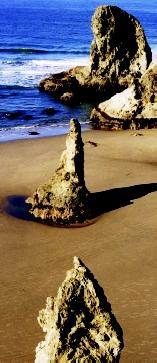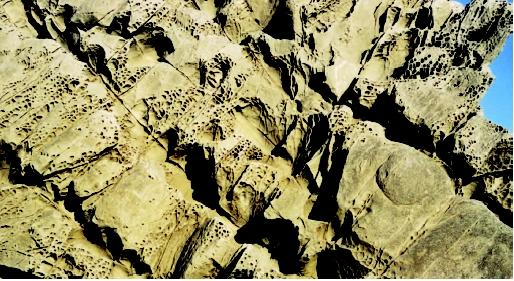
Weathering of Rocks
Weathering is the alteration of rocks to more stable material from their exposure to the agents of air, water, and organic fluids. No rock is stable or immune to weathering. Many pathways and agents are involved in weathering, but most can be grouped into two main processes: mechanical and chemical weathering.
Mechanical weathering includes processes that fragment and disintegrate rocks into smaller pieces without changing the rock's mineral composition. Chemical weathering is the alteration of the rock into new minerals. Both pathways constitute weathering, but one process may dominate over the other.
The two processes can be demonstrated with a piece of paper. It can be torn into smaller pieces, which is analogous to mechanical weathering. It also can be burned into carbon dioxide and water, which is analogous to chemical weathering.
A rock that is weathered into new minerals but still looks somewhat like the parent rock is called a saprolite. If the saprolite fragments are subsequently removed from the site by water, wind, gravity, or ice, erosion has taken place.
Mechanical Weathering
Any process that exerts a stress on a rock that eventually causes it to break into smaller fragments is a type of mechanical weathering. The process of water freezing in rocks is probably one of the most important forms of mechanical weathering. On freezing, water expands 9 percent. If it is occupying a crack completely, the crack will grow. Continued cycles of freezing and thawing in rocks containing water will cause them to fragment into smaller pieces. This is called frost wedging.
The absorption of water by swelling clays, called smectites, causes rocks to split. Plant roots also wedge themselves into cracks in rocks and break them up. Forest fires cause the outsides of rocks to expand, crack parallel to the surface, and eventually "spall" off. Salt crystals might form in pores of rocks from the evaporation of sea mist and cause the pores to break apart. Rocks under pressure from an overburden of rocks and sediment might form cracks parallel to the surface when the overburden is removed by erosion, and the rocks expand from this pressure release. These joints are called exfoliation cracks.
Each of these is an example of mechanical weathering: The rocks have shattered, but their minerals have remained the same. Examples of mechanical weathering are dominant in cold climates, where chemical weathering occurs at such slow rates that the fragmentation processes are obvious.
Chemical Weathering
The process of chemical weathering generally occurs in the soil where water and minerals are in constant contact. Agents of weathering are oxygen, air pollution, water, carbonic acid, and strong acids. They combine with the minerals in rocks to form clays, iron oxides, and salts, which are the endpoints of chemical weathering.

Water plays a very important role in chemical weathering in three different ways. First, it combines with carbon dioxide in the soil to form a weak acid called carbonic acid. Microbe respiration generates abundant soil carbon dioxide, and rainwater (also containing atmospheric carbon dioxide) percolating through the soil provides the water. Carbonic acid slowly dissolves away minerals in rock, especially the carbonate minerals that make up limestone and marble. The weak acid decomposes the insoluble rock into watersoluble products that move into the groundwater. In high concentrations, these dissolved minerals can cause the water to be considered "hard."
Second, water can hydrate minerals by being adsorbed onto the mineral lattice. The conversion of anhydrite into gypsum is an example.
Finally, the water can break up minerals through hydrolysis . The most common group of minerals, the silicates, is decomposed by this process. Reactive hydrogen ions that are liberated from the water attack the crystal lattice, and the mineral decomposes.
Other agents of chemical weathering are gases and acids. Oxygen combines with the metals in minerals to form oxides such as hematite, limonite, and goethite. They are just like the rust that forms on metal exposed to rain or moisture. Air pollution that contributes to weathering of rock generally contains weak concentrations of strong acids such as sulfuric and nitric acid. Strong acids escaping from steam vents around volcanoes and abandoned mine sites can also contribute to increased weathering of nearby rocks.
Results and Rates of Weathering
What would happen to an outcrop of granite that was exposed to the agents of weathering in a humid, warm environment over millions of years? The quartz grains would be liberated as sand grains. They are very resistant to chemical weathering and stay in the system to make up streambeds, beaches, and dunes. The feldspar minerals would be converted into clays and salts. The biotite and amphibole minerals would become iron oxides and clays.
If no erosion occurred at the site, there would be a soil of clay and iron oxides with some sand grains. Most of the salt would have been removed by groundwater. The large concentration of salts in the oceans is a result of chemical weathering of rocks on land, with the weathered constituents being washed into the seas. Clays are very stable and make up the majority of the most abundant sedimentary rocks—shale.
Rates.
The rates of chemical weathering depend on many factors. First, the more water in the system, the faster the weathering. Second, the higher the temperature, the faster the weathering. So, the fastest rates of chemical weathering tend to occur in the hot, humid tropics. Third, the more mineral surface area exposed in the rock by joints, the faster the weathering. The increased number of cracks in the rock will allow the agents of water and oxygen to interact more intensely with the minerals.
Finally, the type of minerals in the rock will also dictate rates. For example, rocks with less quartz and more calcium feldspars (mafic igneous rocks) will weather faster than rocks with more quartz and sodium feldspars (felsic igneous rocks).
SEE ALSO Fresh Water, Physics and Chemistry of .
Scott F. Burns
Bibliography
Birkeland, Peter W. Soils and Geomorphology, 3rd ed. New York: Oxford University Press, 1999.
Lutgens, Frederick K. et al. Essentials of Geology, 8th ed. Englewood Cliffs, NJ: Prentice Hall, 2002.
Tarbuck, Edward J., and Frederick K. Lutgens. Earth: An Introduction to Physical Geology. Englewood Cliffs, NJ: Prentice Hall, 2002.
DEVELOPMENT OF SOIL
If the products from weathering a rock are not removed from the site by erosion, the accumulation produces a soil. Through time, vegetation grows on the land surface, and rainwater moves through the soil, carrying weathering products from the surface to lower depths and thereby forming soil horizons.
Organic matter accumulates at the surface when vegetation dies, forming the A horizon, or topsoil. Then, mineral subsoil begins to oxidize into a C horizon. As watertranslocated weathering products of clay, iron oxides, and caliche accumulate in the old C horizon, the horizon becomes a B horizon. With time, soils get thicker, gain horizons, and become clay-rich and redder.
but it is better to add chemical equations
thanks
good luck